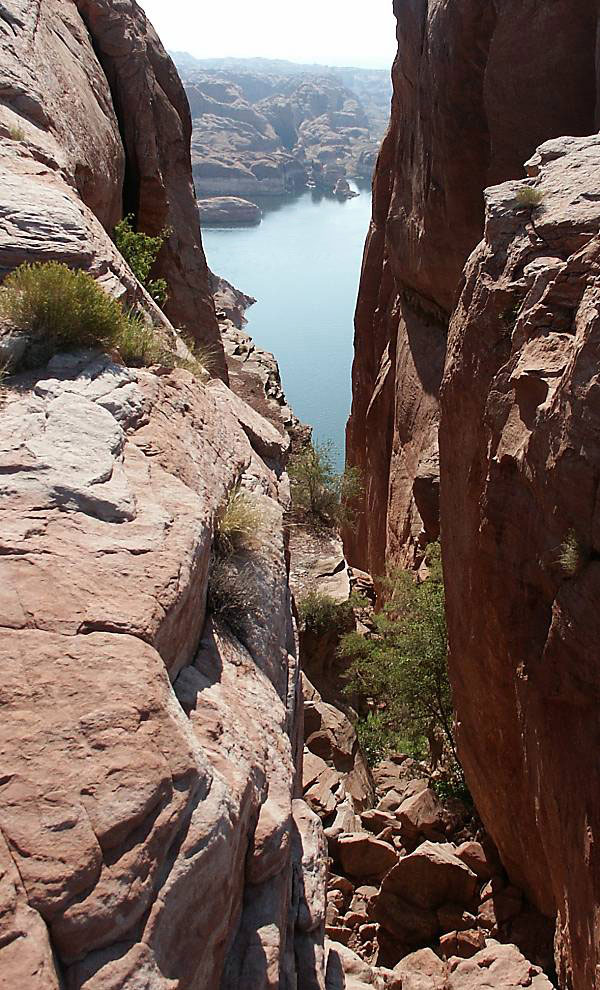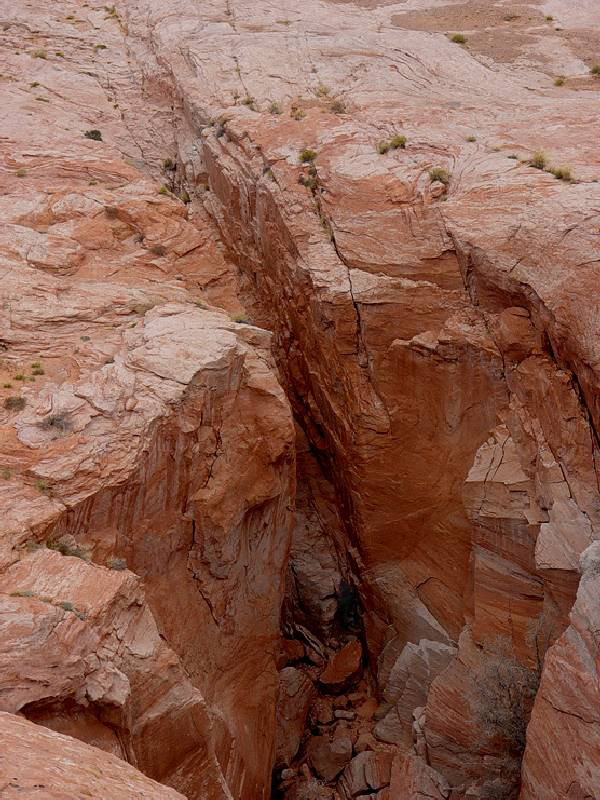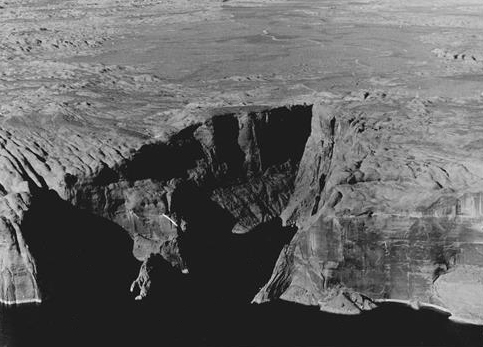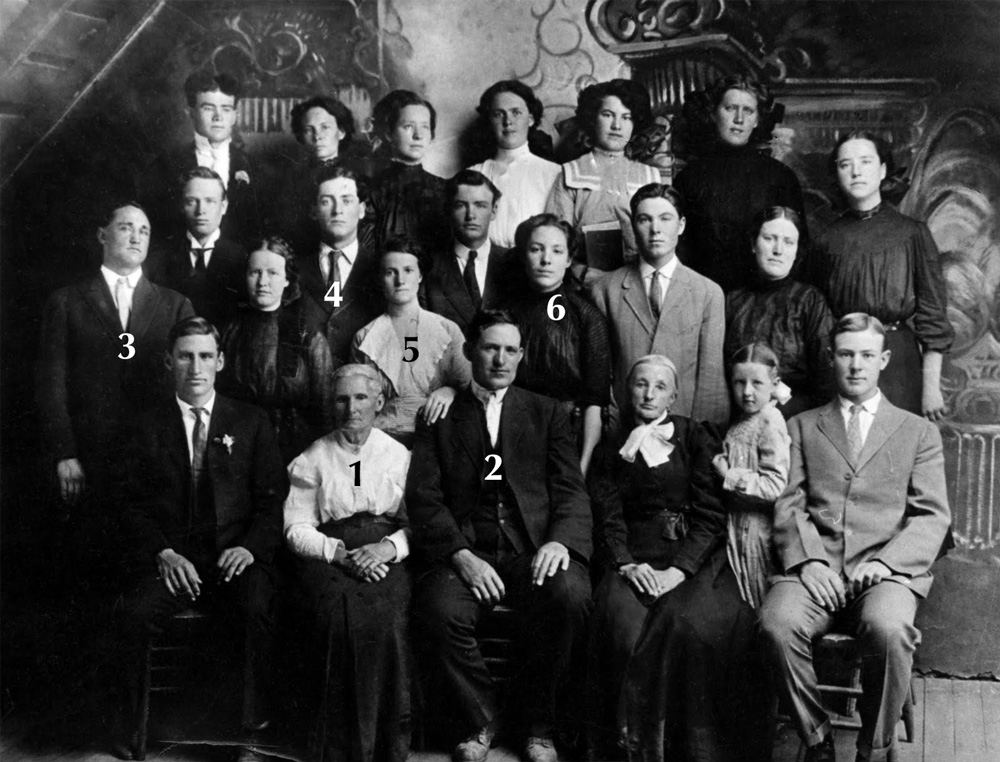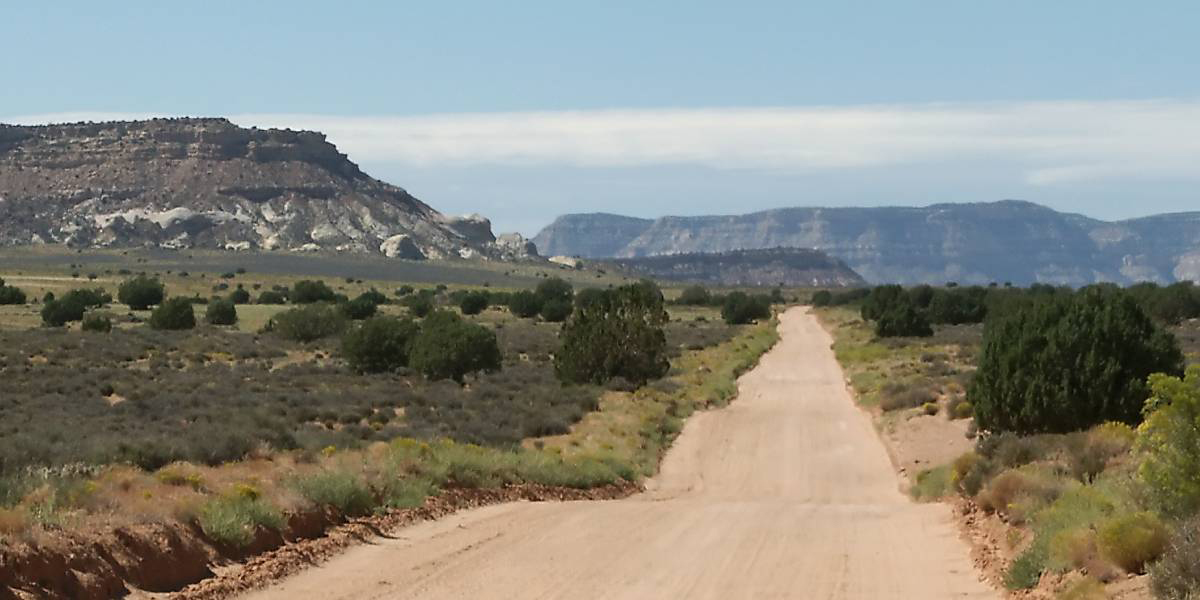Joseph and the San Juan Mission
Also Known as the Holy in the Rock Expedition
Joseph and Mary Ellen Lillywhite
Hole in the Rock, looking down at Lake Powell.
Hole in the Rock, looking down at the upper slot.
Hole in the Rock, aerial view with trail.
1-Mary Ellen Willden (Lillywhite); 2-Charles Willden Lillywhite; 3-E. D. Brown ?; 4-Major Brown; 5-Annie Lillywhite (Brown); 6-Irene Lillywhite (Brown).
Additional resources:
LaRene Porter Gaunt, Associate Editor, “Hole-in-the-Rock,” Ensign, October 1995.
Approximately 100 children were part of the first company of pioneers to go through the Holy in the Rock. In his biography, Charles Willden wrote about the Lillywhite children, of which he was one.
San Juan Expedition, From Wikipedia, the free encyclopedia.
Hole in the Rock Pioneer (pt. 2)
by Charles Willden Lillywhite

Charles Willden Lillywhite
Charles Willden Lillywhite, son of Joseph and Mary Ellen, was on the San Juan Expedition as a child. He wrote Joseph’s biography 55 years after his father’s death. The biography is in the possession of Linda Wright of Blanding, Utah, a descendant of Joseph Lillywhite.
The Call to San Juan
Charles remembers: “Father sold his Beaver holdings, absorbing most of the value in teams, wagons, cows and some cash. In the late summer of 1879, he headed east on the old Escalante trail, joining some 70 wagons of other colonizers encamped on the north bank of the Colorado River at a location where LDS scouts located what they decided was the most feasible point to establish a ferry over the turbulent Colorado River. This location was fittingly named Hole-in-the-Rock.
At this point the west bank rose from the riverbed to a height of several hundred feet, mostly perpendicular. The rains through the ages had work out a cleft in the north bank of these walls of sandstone and it offered the only location where wagons could reach the riverbed without prohibitive cost. This declivity had a short stretch where the canyon walls were a few inches too marrow to permit a wagon to pass and another short stretch where a sloping ledge of sand rock would not permit safe passage. The third impediment was an extremely steep grade, too steep to admit a wagon’s descent under brake control only.”
Hole in the Rock Trail—It passes between the Kaiparowits Plateau and the Escalante River.
“A counsel was held and it was decided to camp on the north bank and send for powder so a fairly safe roadbed could be inexpensively and quickly built. However, several weeks elapsed before the powder arrived and then it was inadequate for the job. By this time the colonists were impatient to break camp and be on their way. After using the scant supply of powder to widen the face of the canyon walls, they drilled a series of holes on the downside of the sloping ledge and drove strong oak pegs in these holes. They then cut and laid poles and brush, covered with small rock and earth to bring the sloping side up to where wagons could be lowered without capsizing. The gorge was now ready for experiment.
The entire population was out the morning of January 1, 1880. To add security to the descent of the heavily loaded wagons, a long, strong rope was attached to the rear axle of each wagon as it was driven down the precipitous declivity in the high towering walls to the riverbed and a landing where a flat ferry boat had been built by those emigrants. They had been detained for more than two months and welcomed the prospect of resuming the journey. Because of their careful operations the entire company of approximately 300 was safely lowered through that gorge and ferried over the turbulent stream within a 24 hour period.”
Irrigation Problems in Bluff
No details are given about the rest of the trip, only saying it was “but a few days” until they arrived camping on the north bank of the San Juan River in Bluff. There was abundant rich tillable ground. “Those pioneers from Utah and Idaho who had no experience combating irrigation problems caused by turbulent and seasonal flooded riverbeds were elated over the apparent feasibility of irrigation from the San Juan River, but alas this dream was hard to realize. A ditch was dug heading some distance from the colony’s lands to bring water from the San Juan through a gravel ditch to irrigate those rich acres. During the night the swollen stream of the River washed out all vestige of the ditch heading, and left the ditch high and dry. The colonists had planted a quantity of garden seeds that needed water.
One ingenious brother devised a waterwheel and by evening the colonists again saw reason to rejoice when water from self-propelled water cups filled and dumped into a trough leading to their irrigation ditches. Imagine their disappointment the next morning when they gazed on a silent waterwheel with the river stream running briskly down a channel some distance from the designated spot. Another lesson learned by those inexperienced colonists! It was at this state that Joseph Lillywhite together with several other men gave up the experiment. While there have been many attempts to settle and till those rich lower San Juan acres, none have been very successful, except many miles further upstream, where smaller tributaries of the San Juan are successfully controlled for irrigation.
Family leaves Bluff for Arizona
Sometime in the late spring of 1880 Joseph and Mary Ellen loaded their equipment and household effects and headed for Alpine, Apache County, AZ, traveling by way of Fort Defiance and Wingate (both US Army posts) where needed supplies could be purchased. Charles continues: “We traveled south through Zuni Indian territory with our two wagons, one drawn by a good trusty horse team and the other drawn by a horses and a span of rather weary little mules. We stopped at Wingate for supplies. The mules were not used to the Zuni light colored garb nor the Indians, and they shied and it took all hands of the children to avert a runaway.
The family arrived with cattle and wagon in Alpine, nestled among the tall mountain peaks between New Mexico and Arizona. Alpine was a “veritable paradise with black, rich, mountain soil. However, because Joseph had been shot through the right lung, he was in poor shape to withstand the rigors of the mountain climate, and the family relocated to Woodruff, Arizona and a milder climate.
In late summer of 1881, the family finances were getting painfully low, and because there was a demand for teams and men to help build the Atchison-Topeka and Santa Fee Railroad grade being built in northern Arizona, Joseph loaded his family and household into wagons again and drove to Winslow, AZ. They pitched their tens there. Charles drove the ox teams while his brother Joseph Jr. dumped and filled the “slip scrapers.” They worked there until the summer of 1882, when the grade was completed.
They ended up heading back to Woodruff, and selected a city lot. At that time the town only had nine thatched roofs, homes with dirt floors, and bare adobe rooms making up the triangle fort where they stayed.
During the summer of 1887, a measles epidemic prevailed in Woodruff and little brother John who was 10 years old was stricken. Pneumonia complicated his recovery from measles, and “we gathered about his bedside to witness his most earnest pleadings: ‘Don’t let me die, Papa. Pray for me.’ The little fellow sat up in bed and plead as I have never heard another plead for life, until his voice became a whisper but his lips still moved in pleading for life. My good father earnestly prayed for his recovery until John’s voice was stilled in death. I have witnessed many pass away but never one who plead for life as that noble little fellow. Someday we’ll understand.”
Death of Joseph
Charles continues: “His passing left a vacancy in the family but more was demanded, for at 4 AM on January 18, 1888, I stood beside the death bed of my good father as his eyes closed. How I loved and was just learning to appreciate the companionship of my devoted father when pneumonia cut him down and left that grief stricken family far away from all relatives and the land of my birth, Utah. My brave mother dried her tears during the day and faced the lonely trying days with a fortitude that only real pioneers can muster. My sister May confided to me that for months after father’s death she found tear stains on mother’s pillow when she made the beds.
Joseph’s untimely death, Jan. 19, 1888, was no doubt hastened by overwork and anxiety over the repeated failures to control the stream for irrigation.

